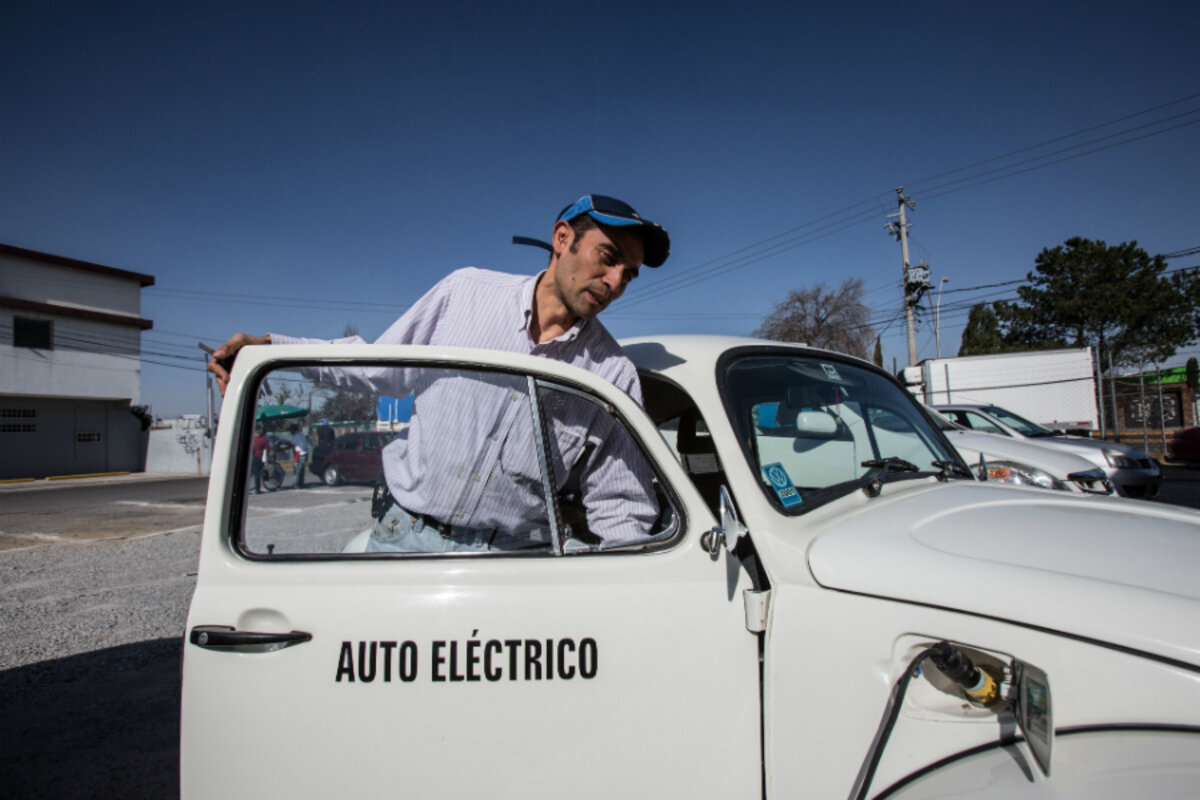Mexico's pollution: how two entrepreneurs are driving change by embracing old cars
Loading...
| Metepec, Mexico State
After decades as the standard taxi model in Mexico City, the Volkswagen Bug is considered “classic” Mexico.
But it could also embody the future, according to an engineer and computer scientist duo here ��– with a key adjustment.
Take the 2002 white VW Bug parked in the gravel lot alongside Alto Rendimiento Automotriz, Álvaro de la Paz’s car shop. An extension cord runs from a connection by the front wheel well��to a household outlet. The engine has been replaced with an electric motor held up by handcrafted supports, and the back window looks down on rows of bright blue lithium batteries. An old VW bumper sticker is amended in black marker to read, “It’s not a car… It’s aN ELECTRIC Volkswagen.”
Mr. de la Paz and his apprentice and partner, Héctor Ruiz García, have been working together for the past five years to transform old, polluting cars into electric vehicles. It’s a passion project that both men hope will create lasting change in attitudes here toward driving, the environment, and personal health.
“We are making a difference,” says Mr. Ruiz, who has more than 25 years of experience working in computer technology. “It may not be on a large-scale, but we are helping people do more with less and offering real solutions to [environmental] problems.”
Pollution has long been a challenge in this megalopolis of more than 20 million people. Mexico City slowly shed its reputation as one of the most polluted cities in the world by moving industry outside the metropolitan area in the 1990s, creating stricter emissions requirements, and expanding public transportation and bike paths. The city now has more than 90 miles of dedicated bike lanes and in 2012 opened the 12th�� line of one of the most traveled metro systems in North America. Other cities around the globe adapted some of its programming, like Hoy No Circula, a program that bans cars from driving certain days of the week in an effort to decrease emissions.��
But about 200,000 new cars hit the road here each year, according to the city government. And the old clunkers that still circulate are some of the biggest culprits for emitting dangerous pollutants. Last spring, when Mexico City experienced an “extraordinary increase” in ozone concentration, the highest levels of pollution the city had seen since 2005, the driving bans increased, keeping some cars off the road for multiple days a week.
It may not have helped. A recent study by economist Lucas Davis, an associate professor at the Haas School of Business at the University of California, Berkeley, found that Mexico’s driving ban, despite its popularity with policymakers, doesn’t in fact work in lowering emissions. Drivers find ways around the regulations by borrowing cars or taking taxis.
The study’s results underscore the value of citizen-led efforts like those of de la Paz and Ruiz.��
“The government needs to resolve these problems, but they can’t do it alone,” says de la Paz. “They need citizens to be active and involved.”
And it’s not just de la Paz and Ruiz. Other burgeoning programs are gaining a following – even if only on a small scale – for their attention to environmental impact. There’s an electric scooter company, modeled after popular city bike share programs, that’s popular among young urban professionals, and an online app that incentivizes bike riding in Mexico City by offering “points” that can be redeemed at local restaurants and shops, like Starbucks. Local activists are also encouraging the expansion of Mexico City’s bus rapid transit system beyond the heart of the city.
A week that makes a difference
It takes de la Paz and Ruiz about one week to change an old car into an electric vehicle. In a small concrete room in the back of the workshop, shelves are lined with batteries, converters, and custom-built chargers and metal accessories to accommodate the weight of different electric motors. The pair has transformed roughly 20 cars over the past five years, first connecting with each other in 2012 via another electric-car fanatic in Sonora state. De la Paz specializes in the mechanics and electricity; Ruiz, in customer service and buying. They are each other’s apprentices.
De la Paz first started experimenting with electric cars about 10 years ago, when he wanted one of his own. He purchased two small electric trucks, typically used in warehouses, and reverse-engineered the technology to understand how the motors worked. The men have since traveled to workshops in the United States, and import the electric motors they use in the cars – once even trying to fly with a motor as carry-on baggage. Ruiz was subjected to extra screening when officials mistook the contraption for a bomb. ��
Their passion for getting more electric cars on Mexican roads is palpable. Ruiz rattles off stats on electric car speeds and emissions, and quickly offers up the keys to his personal vehicle for a test drive. De la Paz tears up when he muses on about the responsibility he feels in his work. He explains how each project is like a puzzle, a satisfying challenge in figuring out how to create a vehicle that is safe, both for the family entrusting him to do the work and for the bystanders who might benefit from cleaner cars.
The men charge $6,000 per car, a sizable price tag but an investment they believe pays off quickly, largely via savings on gas. The price of gas jumped 20 percent on Jan. 1 this year, leading to nationwide protests over the increased cost of driving and associated costs of food and other consumer products. The men believe there’s far more benefit in targeting used cars over buying new electric vehicles from a dealership.
“A striking thing about air quality is that a large fraction of total emissions come from a very small number of vehicles,” says Mr. Davis, who published the report on the shortcomings of Mexico’s driving ban program. “If you’re driving one of these high-emitting cars, you’re imposing a real cost in terms of health on fellow citizens.”��
“I think policy makers are desperate for some kind of solution to [this] massive problem,” of pollution, Davis says. Programs that ban driving have spread to cities including Bogota, Colombia; Santiago, Chile; La Paz, Bolivia; and Delhi.
“At first, they seem reasonable. In 1989, 20 percent of cars were taken off the road [in Mexico City], so you’d think that air quality would improve by 20 percent,” Davis says.��
“But that’s not the case…. If I tell you you can’t drive tomorrow, you get a ride from a friend, neighbor, or family member. Or hop in a taxi or an Uber.” There’s an incentive for cars that aren’t banned to hit the road, providing transportation for those that aren’t allowed to drive that day.
Change the incentive
Ruiz and de la Paz argue that if governments gave subsidies to people to change their cars from gas to electric, instead of subsidizing the purchase of a new electric car, they’d not only help in lowering emissions, but also inject more money into the local economy by supporting initiatives like theirs.
“I don’t think you can ask for voluntary sacrifices,” says Davis. “You need to go directly after the problem,” which includes better emissions testing that isn't susceptible to corruption, gasoline or congestion taxes, and getting the oldest cars off the road.
“I want to be an example, not just talk about the issues,” Ruiz says. “Not because [electric cars are] in style, but because solutions are necessary.”





